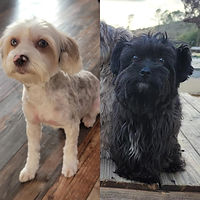Heavenly Parti Yorkies
Home-Grown & Exotic Puppies
_edited.jpg)

The Exotic Type and Colors of Yorkshire Terriers
Yorkshire Terriers, while known for their classic steel blue and tan coats, can also exhibit a range of exotic colors and variations, including black, chocolate, gold, merle, and parti colors. These variations are due to different gene combinations, resulting in unique coat patterns and colors.
Standard Colors:
-
The most common color for Yorkshire Terriers, with black hair on the back and tan coloring on the face, chest, and legs.
-
As the Yorkie matures, their black hair often transitions to a steel blue, while their tan coloring remains.
-
Similar to black and tan, but the tan is replaced with a rich golden color.
-
The steel blue coat is paired with a rich golden color.
Exotic Colors:
-
Black Yorkie: A rare variation where the coat is solid black, due to a dominant gene.
-
Chocolate Yorkie: A rare color where the coat is a rich brown due to a recessive gene that dilutes black pigmentation.
-
Merle Yorkie: Distinctive marbled coat patterns, often with blue or hazel eyes, created by a unique merle gene.
-
Parti Yorkie: Characterized by a blend of colors, usually black, white, and tan, and are purebred Yorkies.
-
Sable (Golden) Yorkies: Have an all-blonde coat due to the predominance of the Pheomelanin gene. A Golden Yorkie is extremely rare as it is hard to find the genetic possibility that results in an all-gold coat color.
-
Red-legged Yorkies: A unique variation of the traditional gold Yorkshire Terrier, where their coats turn into a vibrant red hue. This distinctive coloration is due to a throwback gene that goes back five generations. This Yorkie coat results from both parents carrying copies of a recessive gene. Their coat also tends to be wiry, with long facial hair.
The Type and Colors of Yorkie Puppies My Mommas Will Have:
Alex: Tri-Color Parti, Black and White Parti, Chocolate Parti with mostly White, and all registered with AKC (American Kennel Club).
Mischa and Moonshine: Black and White Parti, Tri-Color Parti, Chocolate Parti, KB Dark Chocolate, KB Black and Merle, all registered with CKC (Continental Kennel Club). Because their mom is a Merle Yorkie and their dad is a KB Black Yorkie (pictured below), they are registered with CKC; AKC does not recognize KB or Merle Yorkshire Terriers.
The male I use for all my girls, is “Lucky,” an AKC Tri-Color Parti Yorkie (photo below):
The Type and Colors of Yorkie Puppies Leah’s Momma Will Have:
Mochi: Traditional (Black and Tan) and Tri-Color Parti.
Primary Differences Between AKC and CKC Registries
The primary difference between the American Kennel Club (AKC) and the Continental Kennel Club (CKC), lies in their registration policies and standards. The AKC is a more traditional, closed registry, requiring both parents to be registered with them and often demanding DNA verification of parentage. The CKC, on the other hand, is an open registry, accepting registration of dogs with less strict requirements, even if the parents aren't registered or if they are missing some documentation.
Here's a more detailed breakdown:
AKC (American Kennel Club):
-
Closed Registry: Only purebred dogs with parents also registered with the AKC can be registered.
-
Strict Standards: Requires detailed documentation of lineage and may require DNA testing to verify parentage.
-
Focus on Purebreds: Primarily focuses on registering and promoting purebred dogs.
-
Established: Founded in 1884, it is the oldest and largest kennel club in the United States.
-
Breeds: The AKC recognizes a specific list of purebred breeds.
CKC (Continental Kennel Club):
-
Open Registry: Accepts registration of purebred dogs, regardless of parentage registration, or even missing documentation.
-
More Relaxed Requirements: Allows registration based on visual confirmation and witness testimony.
-
Broader Breeds: Recognizes over 400 breeds, including mixed breeds.
-
International: Operates in all 50 states and 30 foreign countries.
-
Founded Later: Started in 1991.
Please understand, the quality of puppy has absolutely nothing to do with which club they are registered with. There are unscrupulous and irresponsible backyard breeders in both organizations, as well as plenty of scammers.
The best criteria to use when looking for a puppy, is to always “vet” the breeder: look at past litters, recommendations and research all the ways that are important to you. A legitimate, responsible breeder won’t mind answering questions, showing you their puppies through Facetime, looking at their website for more information and produce a solid contract before any deposits are accepted. Never, ever, send money with promises of a puppy you haven’t seen -- whether it’s on Facebook, Craigslist, Instagram or any other platform. A legitimate breeder will always provide live videos, photos and/or Facetime of the puppies before accepting any deposit and contract.

